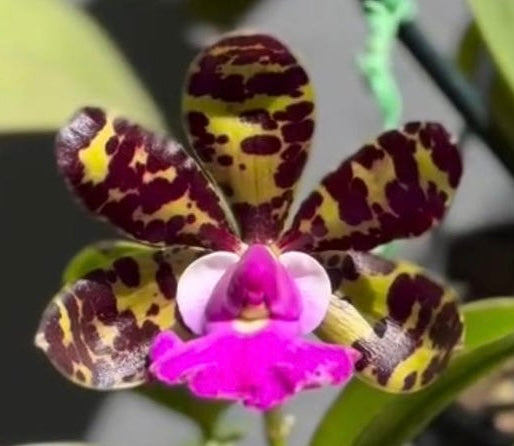
Cattleya aclandiae: Brazil. Introduced in 1839 by Lady Akland, of Killerton, near Exeter, it was named for her by Dr. Lindley when he first described the species in the BOTANICAL REGISTER, in 1840. This is one of the smallest in habit among the Cattleyas, the slender, cylindrical, furrowed stems being from three to five inches long, the two leaves each from two to three inches in length. A short peduncle bears one or two flowers from three to four inches across. Petals and sepals are similar, fleshy, yellowish green transversely blotched and spotted with blackish purple. The rather fiddle-shaped lip is three-lobed, the lateral lobes small and curved toward the column, white tinged with rose, the midlobe broadly kidney-shaped, wavy, bright rose-purple veined with deep purple. The exposed column is short, thickened with wing-like margins, a deep amethyst-purple. Found growing near sea level on small isolated trees in the arid lands near the coast of the province of Bahia, over which a sea breeze blows constantly, it is a warm growing species demanding great light. It requires little compost but should be heavily watered during its growing season. Frequently it produces new growths and flowers twice a year, in May and June, its normal season, and again in the fall. Not common in cultivation, it is a delightful dwarf species with bold flowers, but it is does have a reputation as being difficult to grow.
Large mature plants with lots of growth mounted on cork
Returns Policy
Due to the delicate nature of our orchids, all of our products may not be returned. If you're unhappy with your purchase, please contact orders@orchidclassics2u.com with your order number and reason for dissatisfaction with your order. We will do our very best to ensure you're happy with your Orchid Classics shopping experience.
Shipping
We can ship to virtually any address in the world. Note that there are restrictions on some products, and some products cannot be shipped to international destinations.
When you place an order, we will estimate shipping and delivery dates for you based on the availability of your items and the shipping options you choose. Depending on the shipping provider you choose, shipping date estimates may appear on the shipping quotes page.





